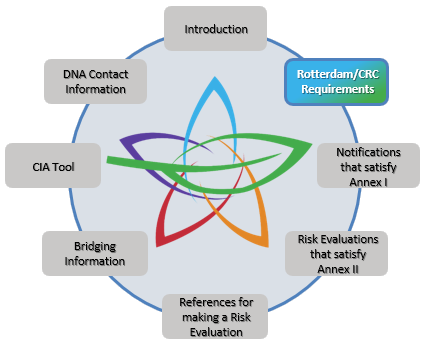The objective of the Rotterdam Convention is to promote shared responsibility and cooperative efforts among Parties in the international trade of certain hazardous chemicals in order to protect human health and the environment from potential harm. Also, to contribute to their environmentally sound use, by facilitating information exchange about their characteristics, by providing for a national decision-making process on their import and export and by disseminating these decisions to Parties.
More
Article 5 of the Convention relates to DNAs fulfilling the responsibility of sharing information regarding decisions on the final regulatory action taken on each chemical. Each Party that has adopted a final regulatory action shall notify the Secretariat in writing of such action and shall contain the information required by Annex I of the Convention, where available. Such notification shall be made as soon as possible, and in any event, no later than 90 days after the date on which the final regulatory action has taken effect.
The notification form to be used is available on the Rotterdam website and is accessible here. Guidance to complete the notification form has been prepared by the Secretariat and is available here.
Chemicals of which the notifications of final regulatory actions satisfy the information requirements of Annex I will be considered by the Chemical Review Committee (CRC) for listing in Annex III of the Convention. The process for considering listing a chemical is as follows:
- A DNA from a particular PIC region notifies the Secretariat of a final regulatory action on a chemical; The Secretariat checks the notification against the information requirements of Annex I of the Convention;
- If this notification satisfies the information requirements of Annex I, it is put aside, waiting for another notification on the same chemical from a DNA of a different PIC region. When the Secretariat receives a second notification on the same chemical from a different PIC region and it satisfies the information requirements of Annex I, the two notifications are forwarded to the CRC;
- The CRC reviews the two notifications on the chemical against the criteria laid out in Annex II of the Convention;
- If the two notifications are in accordance with the criteria of Annex II, the CRC will recommend to the Conference of the Parties to list the chemical in Annex III.
Key links
|
 |
Chemical Review Committee
The CRC is made up of government-designated experts in the field of chemicals management. The members of the CRC are selected through equitable geographical distribution, as assigned and approved by the Conference of the Parties (COP), for a particular period. The COP confirms the appointment of the experts nominated by the Parties, taking into account gender balance and the need for various types of expertise. Each member serves for a term of four years from the date of appointment, and for no more than two consecutive terms.
The Handbook of Working Procedures and Policy Guidance for CRC sets out information on the terms of reference for the CRC and the ways in which the Committee will carry out its mandate.
The risk evaluation accompanying each notification is examined and emphasis is placed on the scientific soundness of it. It is important that Parties try to take a final regulatory action on a chemical based on sound scientific evidence. While developed countries should have the necessary resources and facilities to achieve risk evaluations that satisfy Annex II criteria, such risk evaluations may not be achievable by most developing countries.
The CRC has established and endorsed the process of bridging information. Through this process, developing country Parties can refer to the risk evaluations of other Parties where such other Parties have similar local conditions and have prepared a risk evaluation on a chemical that is based on sound scientific evidence. It should be noted that any risk evaluation used under bridging information must reflect review of the effects of a chemical under local conditions of use.
Annex I and II
Annex I to the Rotterdam Convention contains information requirements for submitting a notification. DNAs are encouraged to seek the required information contained in Annex I at the time that a decision on a final regulatory action is being made on a chemical.
If a DNA does not have all the information when making a decision on a final regulatory action, it is best to seek such information through the Secretariat or contact other DNAs especially from developed countries and also from DNAs from countries with similar local conditions. Please also note that this toolkit has a section on references for making a Risk Evaluation, which provides useful information on this subject.
Annex II to the Rotterdam Convention is established to guide the CRC when reviewing notifications on a chemical. The criteria set out in this Annex is compared with the information provided in each notification along with any accompanying documents. A decision to recommend the chemical for listing in Annex III is based on the notification fulfilling the criteria in Annex II.